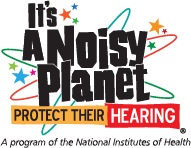March marks a significant month in the life of Alexander Graham Bell. Bell was born on March 3 in 1847. And just 29 years later, in 1876, he received the patent for his design of the telephone on March 7. In honor of Bell, Noisy Planet would like to share a few of the ways in which his work made our lives better.

Bell’s life work was greatly influenced by his family. His grandfather, father, and uncle were teachers of elocution (public speaking). His mother and wife were both deaf. While Bell is best known as one of the inventors of the telephone, he had a deep knowledge of the science of sound and made important contributions to the detection of hearing loss. Among his 30 patented inventions, Bell created the audiometer, which he used to test the hearing of hundreds of people, including children. This device is still used today to measure how well a person can hear.
Did you know that decibels, units used to measure the loudness of sounds, are named for Bell? Once the telephone was created, engineers needed to be able to quantify the audio levels in telephone circuits and measure the transmission efficiency of telephone facilities. Bell Telephone Laboratories devised this sound measurement unit and named it “bel”—in honor of the organization’s founder, Alexander Graham Bell. The decibel is one-tenth of a bel.
The decibel scale helps us understand which noises can damage hearing. Because people can’t hear all frequencies, or pitches of sound, A-weighted decibels (dBA) can be used to describe sound based on what human ears can actually hear. For example, a whisper measures 30 dBA, and normal conversation measures 60-70 dBA. Long or repeated exposure to sounds at or above 85 dBA can cause noise-induced hearing loss. Sources of noise that can cause noise-induced hearing loss over time include dirt bikes, fireworks, concerts, sporting events, and music devices, all emitting sounds between 80-110 dBA. The louder the sound, the shorter the time period before hearing loss caused by noise can occur.
Protect your children’s hearing by giving them earplugs or earmuffs to wear when exposed to sounds that exceed 85 dBA (and don’t forget to protect your own hearing!). Encourage your children to turn down the volume on their headphones or earbuds, which are often 94-110 dBA at their highest volume.
Last Updated Date



